sextet
Fauré - Pièce - Alto Flute & Piano
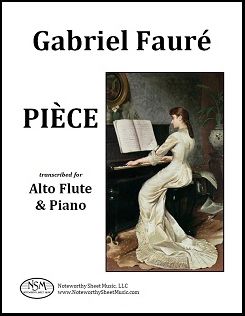 Pièce (Vocalise-Étude), by Gabriel Fauré
Pièce (Vocalise-Étude), by Gabriel Fauré
Transcribed for Alto Flute and Piano by C.A.Vater
Alto Flute Part and Piano Score, PDF $4.99
Vocalises are songs without words written to provide technical challenges for singers; they are designed to develop flexibility and control, and thus often serve as vocal warm-up exercises. Gabriel Fauré composed his Vocalise-Étude in 1906, and it was published by Leduc the following year. The original piece, in the key of E minor and marked Adagio molto tranquillo, includes a piano accompaniment and incorporates various difficulties for the vocal soloist, including wide intervals, unexpected harmonies, and demanding rhythms.
Fauré's Vocalise-Étude has long been recognized as a particularly lovely and poignant piece of music, not merely a vocal exercise but a musical work of intrinsic beauty. Under its alternative name Pièce, the Vocalise-Étude has been transcribed for various orchestral instruments, including bassoon and piano, flute and piano, and oboe and harp. We at Noteworthy Sheet Music think the alto flute, with its rich, mellow tone, is the perfect instrument for this moving and somewhat melancholy Fauré melody. Our transcription for alto flute and piano is based on the version of the Vocalise-Étude for medium voice, in the key of D minor, published by Alphonse Leduc in 1907 and now in the public domain.
Alto Flute part, 1 page; Piano Score, 3 pages; Total, 8 pages.
PreviewFauré - Sicilienne - Alto Flute
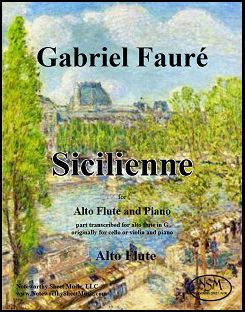 Sicilienne, Op.78, by Gabriel Fauré
Sicilienne, Op.78, by Gabriel Fauré
Transcribed for Alto Flute (and Piano) by C.A.Vater
Alto Flute Part, PDF $3.79
Sicilienne (Opus 78) was composed by Gabriel Fauré in 1893 and first published as a chamber music version for solo cello or violin with piano accompaniment in 1898. Numerous transcriptions of this popular piece have been made, including arrangements for flute and piano, viola and piano, horn and piano, flute and harp, 2 flutes and piano, flute and clarinet, and piano solo, among others. Our alto flute part is a transcription based on the original violin and cello parts of the edition published by J. Hamelle in 1898. We provide only the transcribed alto flute part; the piano accompaniment is readily available as a free pdf download of the original score for piano and cello, now in the public domain.
Alto Flute part, 2 pages of music; Total, 4 pages.
Finlayson - 3 Pagan Dances - Percussion Ensemble
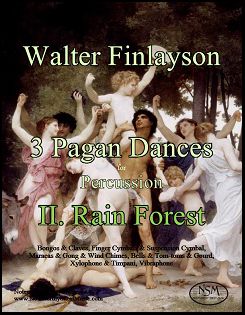 3 Pagan Dances, by Walter A. Finlayson
3 Pagan Dances, by Walter A. Finlayson
Contemporary Compositions for Percussion Ensemble
I. Goddess of the Earth: Score and Parts, PDF $8.99
II. Rain Forest: Score and Parts, PDF $6.99
III. Temple of the Sun: Score and Parts, PDF $13.99
Noteworthy Sheet Music's chief editorial consultant Peter H. Bloom received Walter Finlayson's previously-unpublished score for 3 Pagan Dances from the composer's daughter, and we were delighted for the opportunity to become acquainted with this rousing, intoxicating work. For our publications, we've opted to create separate editions for the three pieces, giving players the choice of acquiring only one or two of the 3 Pagan Dances at a time, depending on their level of interest and performance needs. In each case we have maintained the composer's allocation of instruments per player. Pagan Dance I. Goddess of the Earth is scored for (1) snare drum/suspension cymbal/gong, (2) tom-toms, (3) temple blocks/xylophone/cowbell, (4) bells, (5) chimes, and (6) timpani. Pagan Dance II. Rain Forest is scored for (1) bongos/claves, (2) finger cymbals/suspension cymbal, (3) maracas/gong/wind chimes, (4) bells/tom-toms/gourd, (5) xylophone/timpani, and (6) vibraphone. Pagan Dance III. Temple of the Sun is scored for (1) xylophone, (2) tom-toms, (3) temple blocks, (4) gong/suspension cymbal, (5) chimes/crash cymbal, and (6) timpani. Our editions of the 3 Pagan Dances include both scores and parts.
Click on the MP3 icons below to listen to audio samples from a 1964 performance of the work:
I. Goddess of the Earth audio ![]()
![]() II. Rain Forest
II. Rain Forest![]() III. Temple of the Sun
III. Temple of the Sun
We at NSM are pleased to aid in the re-discovery of some of Walter Finlayson's compositions; for additional biographical information about this remarkable composer, please visit the Our Composers page.
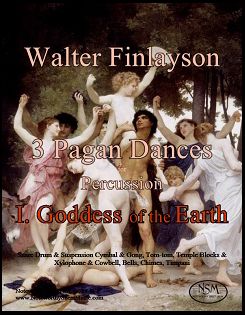 I. Goddess of the Earth: Score, 8 pages; Parts for (1) snare drum/suspension cymbal/gong, (2) tom-toms, (3) temple blocks/xylophone/cowbell, (4) bells, (5) chimes, and (6) timpani, 1 page each; Total, 16 pages
I. Goddess of the Earth: Score, 8 pages; Parts for (1) snare drum/suspension cymbal/gong, (2) tom-toms, (3) temple blocks/xylophone/cowbell, (4) bells, (5) chimes, and (6) timpani, 1 page each; Total, 16 pages
Preview I
 II. Rain Forest: Score, 6 pages; Parts for (1) bongos/claves, (2) finger cymbals/suspension cymbal, (3) maracas/gong/wind chimes, (4) bells/tom-toms/gourd, (5) xylophone/timpani, and (6) vibraphone, 1 page each; Total, 14 pages.
II. Rain Forest: Score, 6 pages; Parts for (1) bongos/claves, (2) finger cymbals/suspension cymbal, (3) maracas/gong/wind chimes, (4) bells/tom-toms/gourd, (5) xylophone/timpani, and (6) vibraphone, 1 page each; Total, 14 pages.
Preview II
 III. Temple of the Sun: Score, 13 pages; Parts for (1) xylophone, 2 pages, (2) tom-toms, 2 pages, (3) temple blocks, 2 pages, (4) gong/suspension cymbal, 1 page, (5) chimes/crash cymbal, 1 page, and (6) timpani, 2 pages; Total, 26 pages.
III. Temple of the Sun: Score, 13 pages; Parts for (1) xylophone, 2 pages, (2) tom-toms, 2 pages, (3) temple blocks, 2 pages, (4) gong/suspension cymbal, 1 page, (5) chimes/crash cymbal, 1 page, and (6) timpani, 2 pages; Total, 26 pages.
Preview III
Gade - Fantasy Pieces - Alto Flute
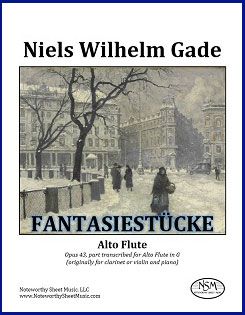 Fantasiestücke, Op.43, by Niels W. Gade
Fantasiestücke, Op.43, by Niels W. Gade
Transcribed for Alto Flute (and Piano) by John W. Pratt
Alto Flute Part, PDF $6.99
Niels Wilhelm Gade (1817–1890) became the preeminent figure in 19th century Danish musical life after an early success in Copenhagen and five years in Leipzig as Mendelssohn's assistant and successor. His Fantasiestücke (Fantasy Pieces, Opus 43) for clarinet (or violin) and piano were published in 1864, apparently his only work published that year although others were in progress. They are dedicated to the clarinetist "Herrn Kammermusiker Mozart Petersen." Our flute transcriptions take into account the nature of the flute and the discrepancies between Gade's original score and the clarinet and violin parts. We provide our alto flute part; the piano score is readily available in the public domain as a free pdf download of the score for clarinet and piano. Here is a link to one such source: Piano Score
Alto Flute part, 7 pages; Total, 10 pages.
PreviewGlazunov - Elegy - Flute or Alto Flute
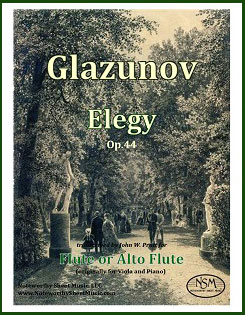 Elegy, Op.44, by Alexander Glazunov
Elegy, Op.44, by Alexander Glazunov
Transcribed for Flute or Alto Flute (and Piano) by John W. Pratt
Parts for Flute and Alto Flute, PDF $5.99
Alexander Konstantinovich Glazunov (1865-1936) was a major composer in the late Russian romantic tradition. His Elegy, Op.44, was written for viola and piano in 1893. The viola melody is readily adaptable for other instruments, since it is without double stops, and has been transcribed here by John W. Pratt for either flute or alto flute. The piece is about 6 minutes long, elegiac but not lugubrious. It consists of a lovely melody in 9/8 time, enhanced by a simple but warm piano accompaniment. The NSM edition includes a flute part and an alternative alto flute part, but does not include one for piano, since a suitable score is freely available at IMSLP.org.
Flute part, 2 pages; Alto Flute part, 2 pages; Total, 8 pages.
PreviewGoepfart - Zwei Charakterstücke - Alto Flute and Piano
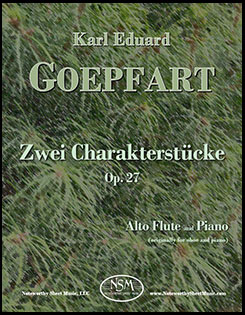 Zwei Charakterstücke, by Karl Eduard Goepfart
Zwei Charakterstücke, by Karl Eduard Goepfart
transcribed for Alto Flute and Piano by C. A. Vater
Alto Flute part and Piano score, PDF $8.99
Karl Eduard Goepfart (1859-1942) was a German pianist, composer and conductor. His Zwei Charakterstücke, Op. 27 (Two Character Pieces) were written for oboe and piano and first published in Leipzig in 1888. The two contrasting pieces are the very charming Mässig schnell, gehend and Mässig langsam (in ruhiger Bewegung) with its playful, energetic Lebhaft section. We prepared a transcription of this under-appreciated work for alto flute, complete with piano score. The pieces work well on alto flute, providing the accompanying pianist is sensitive to the alto flute’s lower sound power and projection capability, especially in the low register, compared to that of the oboe.
Piano Score, 8 pages; Alto Flute part, 3 pages; Total, 16 pages.
PreviewHatton - Wreck of the Hesperus - Theatre Orchestra
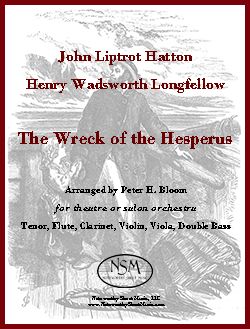 The Wreck of the Hesperus, by J. L. Hatton & H. W. Longfellow
The Wreck of the Hesperus, by J. L. Hatton & H. W. Longfellow
Arranged for theatre or salon orchestra by Peter H. Bloom
Tenor, Flute, Clarinet, Violin, Viola, & Double Bass Parts, and Mini-Score ― PDF $19.98
The "dramatic scena" was an especially popular entertainment at its zenith in the mid-nineteenth century throughout the English speaking world. John Liptrot Hatton's setting of Longfellow's Wreck of the Hesperus is the very model of the dramatic scena at its finest, and a magnificent showcase for an heroic tenor. Longfellow's ballad recounts a chilling tale loosely based on conflated reports of two New England shipwrecks that occurred during a single devastating blizzard in 1839. This arrangement of Wreck of the Hesperus for theatre or salon orchestra was made for the now retired D.C. Hall's New Concert and Quadrille Band of Boston, and their extraordinary tenor Kevin McDermott. It can be heard on the Hall's Band's CD recording "Grand Concert," winner of the Noah Greenberg Award of the American Musicological Society. (excerpted from Peter H. Bloom's © foreword)
Click the mp3 icon to listen to an audio clip of Wreck of the Hesperus from the Hall's Band CD recording Grand Concert!. ![]()
The D.C. Hall's Grand Concert! CD is available from NSM - click to access the page.
Tenor part, 4 pages; Flute part, 2 pages; Bb Clarinet part, 2 pages; Violin part, 2 pages; Viola part, 2 pages; Double bass part, 2 pages; Mini-Score, 8 pages; Total, 26 pages.
Preview===========================================
We also offer a professionally-printed hard copy edition of The Wreck of the Hesperus for $29.97 plus a $5.95 shipping and handling fee to addresses in the USA. Please use the Contact Us form to let us know which hard copy publication(s) you would like to purchase, along with your email contact information and USPS mailing address. We will then send you a PayPal invoice for the sale and, once we receive notice from PayPal that you have paid for the item(s), we will ship your music to the address provided.
Hauptmann - Bereavement - Alto Flute & Piano
 Lento - Bereavement, by Moritz Hauptmann
Lento - Bereavement, by Moritz Hauptmann
Transcribed for Alto Flute and Piano by C. A. Vater
Piano Score and Alto Flute Part, PDF $3.99
Hauptmann's 3 Violin Duos, Op.16 were first published in 1832. The Lento (Bereavement) from Op.16 later was arranged for violin and piano by the renowned violinist, violist, and composer Heinrich Wilhelm Ernst. It is this arrangement by Henri Ernst, published in 1880, that served as the basis for NSM’s transcription of the piece for alto flute and piano. The mournful simplicity of the Lento is perfectly captured and beautifully rendered by the alto flute.
Alto Flute part, 1 page; Piano Score, 2 pages; Total, 6 pages.
PreviewHaydn - Adagio from Sym. No.24 - Afl & Pf
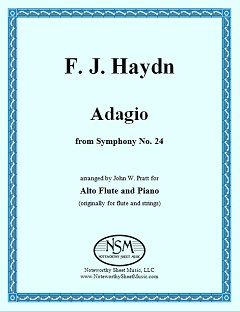 Adagio from Symphony No.24, by F. J. Haydn
Adagio from Symphony No.24, by F. J. Haydn
Arranged for Alto Flute and Piano by John W. Pratt
Alto Flute Part and Piano Score, PDF $6.00
We offer a flute and piano edition of the gorgeous second movement Adagio for solo flute accompanied by strings from Haydn's Symphony No.24. An arrangement for alto flute that is mellower than that for flute but also extremely beautiful is obtained by lowering the pitch a minor third. Haydn's flute part needs no other change, nor does the cadenza that was written by Mr. Pratt for our C-flute edition. The string parts have been adapted to piano sonority in a number of ways, as well as transposing them in this alto flute edition.
Alto Flute part, 2 pages; Alto Flute & Piano score, 4 pages; Total, 10 pages.
PreviewHaydn - Adagio, Quartet Op.17, No.1 - Afl & Pf
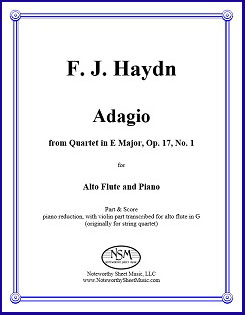 Adagio from Quartet in E Major, Op.17, No.1, by F. J. Haydn
Adagio from Quartet in E Major, Op.17, No.1, by F. J. Haydn
Transcribed for Alto Flute and Piano by John W. Pratt
Alto Flute Part and Piano Score, PDF $8.00
Haydn's early quartets, especially the three sets of six written between 1768 and 1771 (Opus 9, Opus 17, and Opus 20), advanced the development of the classical string quartet enormously in all respects. The third movement of Opus 17, No. 1 is an Adagio with a beautiful violin melody that is harmonized simply by the other three strings. Whereas Haydn's more complex movements generally are unsuitable for transcription, the relative simplicity of this gorgeous Adagio makes it an exception. We present here a transcription for alto flute and piano. The melody is highly effective on the alto flute, and the other string parts are readily adaptable to the piano.
Alto Flute part, 2 pages of music; Piano score, 6 pages; Total, 12 pages.
Preview